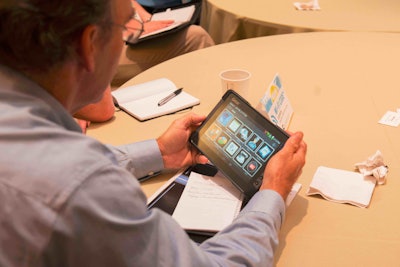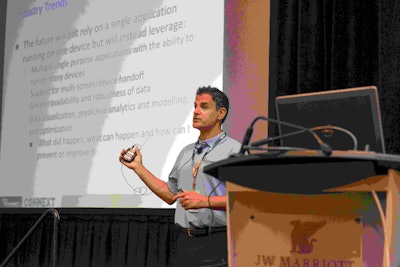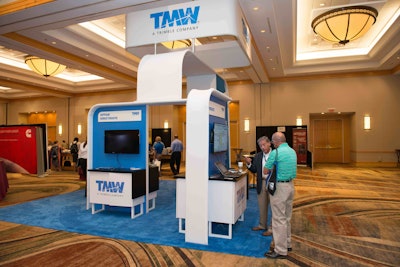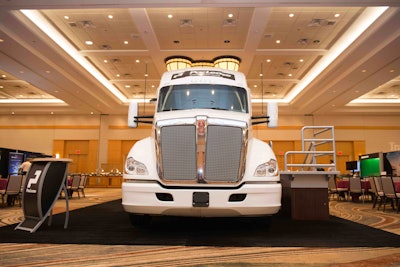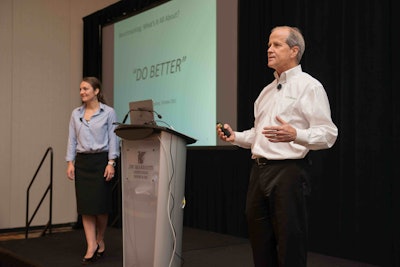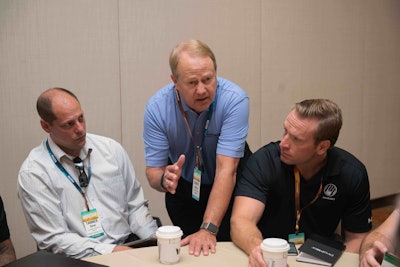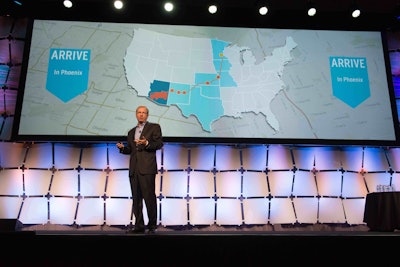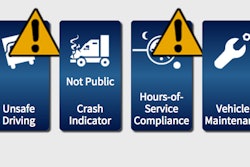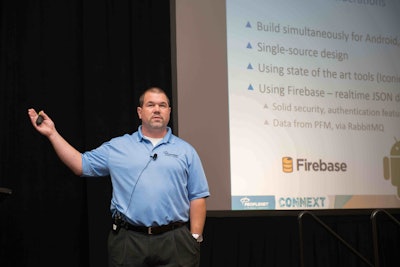 Jim Lowell, chief software engineer for PeopleNet, talks about the architecture that supports the new ConnectedDriver suite of mobile apps.
Jim Lowell, chief software engineer for PeopleNet, talks about the architecture that supports the new ConnectedDriver suite of mobile apps.After a few PowerPoint slides and a description of how the new ConnectedDriver app works, Jim Lowell plugged his smartphone into the projector on stage.
“I want to show you a demo,” said Lowell, chief software engineer for PeopleNet during the company’s 13th annual user conference, held Aug. 25-26 at the J.W. Marriott Desert Ridge Resort in Scottsdale, Ariz.
Live demoing a new product to a roomful of customers is risky, but it was too late to turn back. The audience was now looking at a supersized version of his phone screen.
In the real world, Lowell explained, the app on a driver’s phone would need to be joined to a truck operating with the in-cab PeopleNet platform. Once this validation was made, the driver could see live dispatch messages, hours of service status, and other real-time data in the mobile app.
Using a laptop PC with an Internet connection, he created a dispatch message by going into the PeopleNet Fleet Manager. This online management portal is what fleets use to communicate with their drivers, to view reports, and perform other functions.
“I’m going to send a dispatch to this truck and I want you to see how fast it is. Three, two, one, send,” said Lowell. Three seconds later, the dispatch message had already gone through PeopleNet’s cloud-based network and appeared in the app. “Everything is that fast. All the messages get there that fast. All of the dispatches get there that fast.”
The mobile app and the lightning-fast movement of data through the cloud were part of the much bigger announcement at the conference: a new ConnectedFleet Platform that connects people, equipment and devices to a “fully managed, cloud-based vehicle network” that resides in a public cloud instead of in PeopleNet’s own data centers.
This change of strategy and architecture now makes it possible for third party developers, fleet customers, and PeopleNet itself to utilize real-time data to support a growing ecosystem of mobile and web-based applications.
The new platform consists of the following four components:
- PeopleNet Cloud
 Brian McLaughlin, president of PeopleNet, speaks during the opening session of the conference on Monday, Tues., Aug. 25
Brian McLaughlin, president of PeopleNet, speaks during the opening session of the conference on Monday, Tues., Aug. 25This component is not a product, per say, but a term PeopleNet coined to describe its next-generation cloud architecture. Going forward, all of the data collected by its ConnectedFleet platform will be “packaged up” to allow real-time integration with a virtually limitless supply of software applications.
The PeopleNet Cloud uses a message-broker design that enables a “publish and subscribe” ecosystem of mobile and web-based applications. A more simple explanation is that PeopleNet will support a wide range of application programming interfaces (APIs) and protocols to give third parties and customers better access to the data, says Mark Botticelli, chief information officer.
John Reed, the chief information officer of AIM NationaLease, a full-service leasing company with dedicated contract operations, gave one example of something he wants to “subscribe” to. The fuel-level readings from trucks, he says, would be a useful addition for fuel economy reports and route planning applications.
- PeopleNet Mobile Gateway
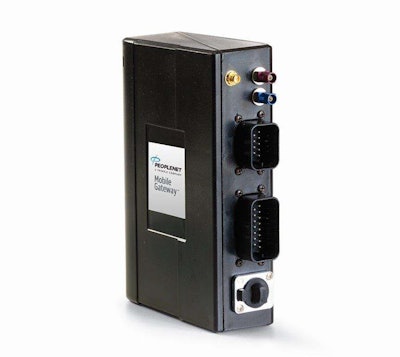 The PeopleNet Mobile Gateway
The PeopleNet Mobile GatewayThe ConnectedFleet platform is powered by the new PeopleNet Mobile Gateway (PMG) system. Designed for quick and easy installation in trucks, the PMG is an intelligent device that serves as the central hub for connecting vehicles, drivers, fleet managers and mobile devices — including wearables — to the PeopleNet Cloud.
Botticelli describes the PMG as “a cloud on wheels” and “a roaming data center” that has the same integration capabilities as the PeopleNet Cloud but specifically for the vehicle environment. The PMG supports applications, mobile devices, sensors, wearables and other Internet of Things in transportation, he says.
The PMG operates on high-speed 4G networks and acts as a wireless access point within the vehicle. With this connectivity, users can access vehicle and third-party data such as weather, traffic patterns, dispatch events, and route corrections, the company says, and access to video for streaming. It also includes the option to open a Wi-Fi hotspot for drivers to connect their personal devices to the Internet.
“We want to help companies retain drivers and potentially attract new drivers with these tools,” said Mark Kessler, general manager of PeopleNet’s Trucking division.
The PMG is now being installed in all Peterbilt and Kenworth trucks with the Maxx Force 13-liter engines at the factory. Commercial availability in the aftermarket is scheduled for the third quarter of 2015.
- PeopleNet Mobile Software for Android Operating Systems

Fleets can select the PeopleNet ConnectedTablet option or one of many PeopleNet-certified off-the-shelf devices, depending on specific needs.
For personal enablement, the PMG has a “kiosk mode” that allows the fleet customer to control what apps can be downloaded to company-owned mobile devices. This feature also cordons off the core apps, like electronic logs and messaging, from being interfered with.
- ConnectedDriver
The ConnectedDriver is a suite of companion apps for PeopleNet’s in-cab platform. The apps are not meant to take over the in-cab display, but rather to allow a driver to stay connected with dispatch, trip messaging and hours-of-service information while away from the truck.
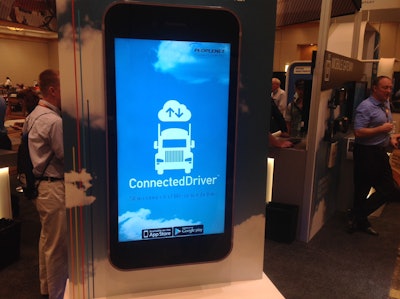 PeopleNet announced a suite of mobile apps to keep drivers connected while outside the truck.
PeopleNet announced a suite of mobile apps to keep drivers connected while outside the truck.The app is now commercially available on Android and Apple iOS devices. The initial launch includes functions to alert the driver that he/she has received a new dispatch; informing the driver of his/her hours of service availability; and offering read-only messaging.
“More and more, drivers are requesting a technology solution that allows them to use their personal mobile devices, but also stay connected to their company while on the road,” said Randy Boyles, the senior vice president of Mobile Strategy at PeopleNet.
Two-way messaging will be a future enhancement to the mobile app, Boyles says. Also on his to-do list is adding feedback features for drivers to review shipper facilities and other points of interest.
Boyles added that he wants to incorporate features to give drivers an accurate view of their on-time performance, time spent on stops, and other measures relative to their fleet averages. He also plans to offer fleets the option have the app automatically shut down while the vehicle is in motion.
Video Intelligence
While technically not part of the ConnectedFleet platform, PeopleNet also announced new features for its Video Intelligence system at the conference.
Video Intelligence uses cameras to capture video around the vehicle. A separate DVR on the vehicle stores and transmits video to an online portal for fleet managers to review when a critical event occurs.
At the conference, PeopleNet showcased a new business intelligence tool that incorporates safety and compliance information from Vigillo, SpeedGauge, and its own data through the PeopleNet Cloud to score and rank drivers based on risk.
The application also now has tools for fleets to review and score videos of critical events. The scored videos can then be sent to the cab and to drivers’ phones for review and coaching.
- Mark Botticelli, chief technology officer of PeopleNet



